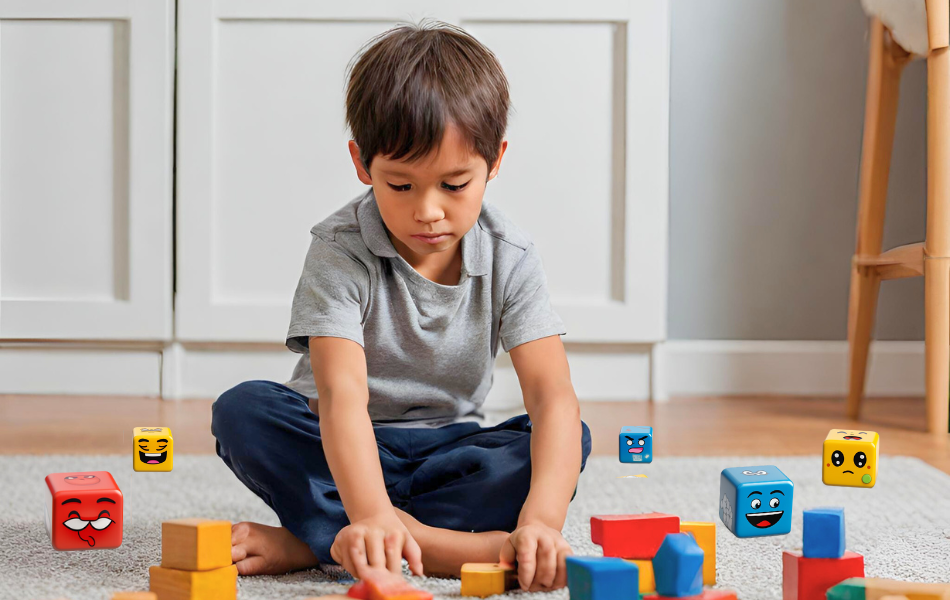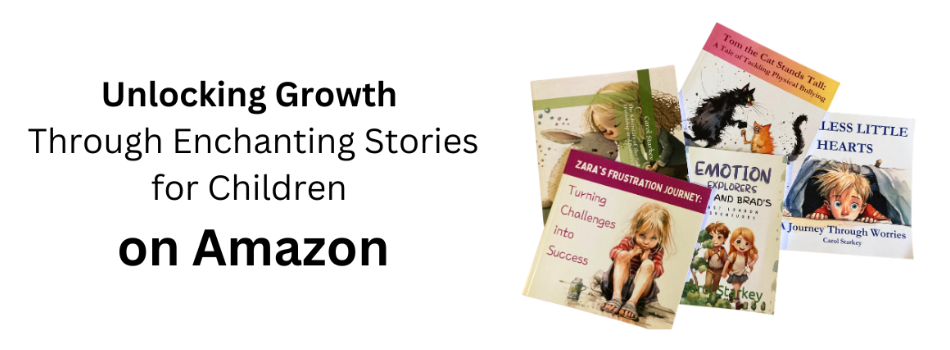Join me on a transformative journey into childhood emotions, as I unlock the secrets to nurturing confidence through fundamental emotional literacy concepts.
In the enchanting world of childhood, emotions play a pivotal role in shaping a child’s experiences and interactions. As we embark on the journey of nurturing young minds, understanding and fostering emotional literacy becomes a fundamental cornerstone. This blog aims to explore the essential concepts of emotional literacy tailored specifically for children, offering insights and practical guidance for parents, grandparents, educators, and caregivers. To understand Emotional Literacy, Intelligence, and Cognition Differences read my introduction blog.
What is Emotional Literacy?
Key components of emotional literacy include:
- Identification of Emotions: The capacity to recognize and label one’s own emotions accurately and promptly.
- Expression of Emotions: The ability to communicate feelings in a clear and appropriate manner, whether through words, body language, or other forms of expression.
- Empathy: Understanding and sharing the emotions of others, demonstrating compassion and sensitivity to their feelings.
- Emotional Regulation: The skill of managing and controlling one’s emotional responses, especially in challenging or stressful situations.
- Social Skills: Applying emotional intelligence in social interactions, including effective communication, conflict resolution, and collaboration.
For children, developing emotional literacy is crucial as it lays the foundation for healthy social and emotional development. It equips them with the tools to navigate relationships, handle conflicts, and cope with the ups and downs of life. Parents, educators, and caregivers play a significant role in fostering emotional literacy by providing a supportive environment that encourages open communication and emotional expression.
The Building Blocks: Identification and Expression

In the foundational realm of emotional literacy for children, the first crucial building block involves the art of identifying and expressing emotions. This pivotal stage sets the groundwork for a child’s ability to navigate and communicate their feelings effectively. Let’s delve into the intricate dynamics of helping children understand and articulate their emotions, fostering a resilient foundation for their emotional well-being.
Recognizing Emotions
Children often experience a whirlwind of emotions, from joy to frustration. Encouraging them to identify and name these feelings is the initial step. Utilize visual aids such as emotion charts or storybooks depicting diverse emotional expressions. Prompt discussions about characters’ feelings in books or movies, helping children relate those emotions to their own experiences.
Expressive Outlets
Providing diverse outlets for expression is vital. Art, play, and journaling can be powerful tools. Encourage drawing or crafting to represent emotions, allowing a non-verbal means of communication. As children engage in play, they naturally act out different emotions, fostering a deeper understanding of these complex feelings.
Open Dialogue
Create a safe space for open communication. Regularly check in with children about their day, asking questions that go beyond the surface. When they express emotions, avoid judgment, and instead, validate their feelings. This instills confidence in sharing emotions and establishes a trustful environment.
Teaching Emotional Vocabulary
Introduce a rich emotional vocabulary. Expand beyond basic emotions like happy or sad, incorporating nuanced terms such as excited, curious, or frustrated. This equips children with a more precise language to articulate their feelings, enhancing their ability to communicate their emotional state effectively.
Modeling Emotional Expression
Children learn significantly by observing. Model emotional expression by sharing your feelings appropriately. Narrate your emotions and reactions in various situations, demonstrating healthy ways to navigate and communicate feelings. This helps them understand that it’s normal to experience a range of emotions.
Encouraging Reflection
Guide children in reflecting on their emotions. Ask questions that prompt self-awareness, such as “Why do you think you feel this way?” This introspection enhances emotional intelligence, enabling them to recognize patterns in their feelings and understand the triggers.
By incorporating these strategies, parents, grandparents, caretakers, and educators play a crucial role in empowering children to recognize and articulate their emotions. This foundational skill not only sets the stage for effective emotional communication but also promotes resilience and a well-rounded emotional well-being.
Embracing Empathy: Understanding Others’ Emotions

Empathy, the ability to understand and share the feelings of others, is a cornerstone of emotional literacy. Teaching children to embrace empathy fosters not only compassionate relationships but also a deeper understanding of the human experience.
Two super games that can be purchased on Amazon are:
- My Feelings, a Fun Game to Help Kids Express Emotions, Improve Social Skills and self Regulation.
- Empathy 4″ Thumball
Modeling Empathetic Behavior
Children learn empathy by witnessing it in action. Model empathetic behavior in your interactions, showcasing kindness, active listening, and consideration for others’ feelings. By observing these behaviors, children internalize the importance of understanding and responding to the emotions of those around them.
Encouraging Perspective-Taking
Nurture the skill of perspective-taking by encouraging children to see situations from another person’s point of view. Engage in discussions that explore different emotions various characters might feel in a story or real-life scenarios. This helps children broaden their understanding of diverse emotional experiences.
Building Emotional Connections
Facilitate opportunities for children to form emotional connections with others. This could involve collaborative activities, group projects, or team sports. Shared experiences build a sense of camaraderie and enable children to relate emotionally to their peers, deepening their empathetic capacities.
Teaching Active Listening
Empathy is closely tied to active listening. Teach children the importance of fully engaging in conversations, and paying attention to both verbal and non-verbal cues. This not only enhances their ability to understand others’ emotions but also establishes a foundation for strong communication skills.
Exploring Diverse Perspectives
Expose children to diverse perspectives and experiences. This can be achieved through literature, cultural activities, or engaging with people from different backgrounds. Understanding a range of emotions in various contexts contributes to a more nuanced and empathetic worldview. (pen pals)
Practicing Acts of Kindness
Encourage acts of kindness as a tangible expression of empathy. Whether it’s helping a friend in need or showing consideration for someone’s feelings, these actions reinforce the connection between understanding emotions and compassionate behavior.
Reflecting on Impact
Guide children to reflect on the impact of their words and actions on others. By developing an awareness of how their behavior influences the emotions of those around them, children gain valuable insights into the power of empathy in shaping positive relationships.
In nurturing empathy, we lay the groundwork for a child’s ability to navigate the complex landscape of human emotions. This essential skill not only contributes to social harmony but also equips children with the emotional intelligence needed for meaningful and empathetic connections throughout their lives.
Emotional Regulation: Managing the Rollercoaster

Navigating the ups and downs of emotions is a vital aspect of emotional literacy for children. Emotional regulation involves the ability to understand, manage, and appropriately express one’s feelings. It serves as a crucial skill in maintaining mental well-being and building resilience.
Understanding the Rollercoaster
Help children recognize that emotions are a natural part of life and that it’s okay to experience a range of feelings. Illustrate emotions as a rollercoaster, with highs and lows, emphasizing that everyone goes through similar rides of emotions.
Breathing and Mindfulness Techniques
Teach children simple yet powerful techniques for calming their minds and bodies. Deep breathing exercises and mindfulness practices, such as focusing on the present moment, help in reducing stress and promoting emotional balance.
Create a Safe Space for Expression
Establish an environment where children feel comfortable expressing their emotions. Encourage them to share their feelings openly without fear of judgment. Knowing they have a safe space to communicate fosters trust and emotional well-being.
Developing Coping Strategies
Work together to identify personalized coping strategies. Whether it’s drawing, journaling, or engaging in physical activities, having a toolkit of coping mechanisms empowers children to navigate challenging emotions constructively.
Recognizing Triggers
Guide children in identifying specific situations or triggers that might intensify their emotions. By understanding these triggers, children can proactively prepare for or manage their responses, fostering a sense of control over their emotional experiences.
Establishing Routine and Predictability
Consistent routines provide a sense of stability and predictability, which can be comforting for children. Knowing what to expect helps them manage their emotions more effectively, especially during times of change or uncertainty.
Encouraging Positive Self-Talk
Teach children to reframe negative thoughts with positive affirmations. Building a habit of positive self-talk contributes to a resilient mindset, empowering children to face challenges with confidence and optimism.
Seeking Support
Emphasize the importance of reaching out for support when needed. Whether it’s talking to a parent, trusted adult, grandparent, friend, or counselor, knowing how to seek help reinforces the idea that managing emotions is a shared responsibility.
By integrating these practical strategies into a child’s emotional toolkit, you play a pivotal role in promoting emotional regulation. This, in turn, cultivates resilience and contributes to the overall mental well-being of children as they navigate the twists and turns of their emotional rollercoaster.
Emotional Intelligence in Social Contexts: Nurturing Meaningful Connections

Emotional intelligence, when applied in social settings, becomes the compass that guides children through the intricate landscape of relationships. This facet of emotional literacy not only enhances personal development but also lays the groundwork for successful interactions within the broader social fabric.
Recognizing Others’ Emotions
In social contexts, the ability to discern and understand the emotions of others is paramount. Engage children in activities that foster empathy, such as role-playing scenarios or discussing characters’ emotions in stories. These exercises help them develop a nuanced understanding of diverse emotional experiences.
Effective Communication Skills
Communication lies at the heart of social interactions. Equip children with the tools for effective expression and active listening. Teach them the importance of clear communication, using “I” statements to express feelings, and being attentive to verbal and non-verbal cues in others.
- Junior Learning Social Skills Board Games from Amazon – for kids from 5 to 8
- You Know Social Skills Games and Therapy Games from Amazon for ages 7+
Empathy in Action
Encourage children to translate their empathetic understanding into compassionate action. This might involve helping a friend in need, offering a listening ear, or engaging in collaborative projects. Practical applications of empathy deepen their connection to others and contribute to a positive social environment.
Conflict Resolution
Teach children constructive ways to navigate conflicts. Understanding that disagreements are a natural part of relationships, guide them in expressing their feelings calmly, actively listening to others’ perspectives, and collaboratively finding solutions. This cultivates a foundation for healthy conflict resolution.
| 1. Active Listening and Empathy: Teach children to actively listen to others during conflicts. Encourage them to express their feelings and thoughts while also taking the time to understand the perspective of the other person. This promotes empathy and helps in finding common ground. | Example: “I hear that you feel upset because I took your toy without asking. I understand why you’re mad, and I’m sorry. Next time, I’ll make sure to ask first.” |
| 2. Use “I” Statements: Guide children to express their feelings using “I” statements, which helps them take ownership of their emotions without blaming others. This promotes open communication and reduces defensiveness. | Example: “I felt sad when you didn’t include me in the game. I would appreciate it if you could let me join next time.” |
| 3. Take a Time-Out: Teach children the value of taking a break when conflicts become intense. A time-out allows both parties to cool down and reflect on the situation, preventing impulsive reactions and creating space for constructive resolution. | Example: “Let’s both take a few minutes to calm down. We can talk again when we’re both ready to listen and find a solution.” |
| 4. Brainstorm Solutions Together: Encourage children to collaboratively come up with solutions to conflicts. This not only empowers them to be active participants in resolving issues but also promotes a sense of shared responsibility. | Example: “We both want to play with the same toy. How about we take turns, or find another game we both enjoy? What do you think would be a fair solution?” |
| 5. Seek Mediation from an Adult: When conflicts persist, guide children to seek the assistance of a trusted adult or mediator. This person can provide guidance, facilitate communication, and help in finding a resolution that is fair to both parties. | Example: “We’ve tried talking about it, but we’re still having trouble. Let’s ask [teacher/parent] for help so we can find a solution together.” |
By instilling these conflict resolution strategies, children develop essential interpersonal skills that contribute to a positive and cooperative social environment. These skills not only address immediate conflicts but also lay the foundation for healthy relationships in the future.
Building Positive Relationships
Explore the qualities of positive relationships, emphasizing traits like trust, respect, and support. Help children recognize these qualities in their interactions and understand the role emotional intelligence plays in fostering enduring and meaningful connections.
Cultural Awareness and Emotional Sensitivity
Promote cultural awareness and emotional sensitivity. Discuss diverse cultural expressions of emotions and encourage an open-minded understanding of how emotions may be expressed differently across various backgrounds. This broadens their cultural competence and enriches their social interactions.
Group Dynamics and Cooperation
Engage children in group activities that foster cooperation and teamwork. This could involve collaborative projects, team sports, or group games. These experiences provide opportunities to apply emotional intelligence in navigating group dynamics and contribute to shared goals.
Celebrating Differences
Emphasize the beauty of diversity in emotions and perspectives. Celebrate differences rather than see them as barriers. This mindset encourages inclusivity and helps children appreciate the richness that diverse emotional expressions bring to social interactions.
By integrating these principles of emotional intelligence into social contexts, children not only enhance their personal relationships but also contribute positively to the communities they inhabit. The development of emotional intelligence in social settings becomes a powerful tool for creating harmonious, empathetic, and resilient social environments.
The Role of Storytelling and Play in Nurturing Emotional Literacy in Children
Storytelling and play, ingrained in the essence of childhood, serve as powerful vehicles for fostering emotional literacy. They offer immersive and engaging avenues for children to explore and understand a rich tapestry of emotions, building essential skills that extend far beyond the realms of imagination.
1. Emotional Vocabulary Development
Through storytelling, children encounter characters navigating a spectrum of emotions. Exposure to a diverse emotional vocabulary helps them articulate and comprehend feelings. Interactive discussions about characters’ emotions encourage reflection and broaden their understanding of the human experience.
Example: “In the story, how do you think the characters felt when they achieved their goal? How would you feel in a similar situation?”
2. Empathy Building
Narratives provide a window into the lives of others, fostering empathy. As children immerse themselves in characters’ emotions, they develop a heightened awareness of different perspectives. Play scenarios, whether with dolls or action figures, allow them to step into the shoes of diverse characters, promoting empathy in a dynamic and hands-on way.
Example: “What do you think the teddy bear feels when it gets lost? Can you show me how you would help it feel better in our play?”
3. Conflict Resolution Skills
Many stories involve characters navigating conflicts. By exploring how characters resolve their issues, children gain insights into constructive conflict resolution. Play acting out these scenarios allows them to experiment with different solutions and understand the impact of their choices on relationships.
Example: “How do you think the characters in the story could find a solution to their disagreement? Let’s pretend to be those characters and see if we can come up with ideas.“
4. Emotional Regulation Techniques
Engaging stories often present characters managing their emotions. Whether it’s taking deep breaths, counting to ten, or seeking support, these stories serve as a platform to introduce and normalize various emotional regulation techniques. Play provides a safe space for children to practice and internalize these strategies.
Example: “In the story, the character felt angry and took a deep breath to calm down. Can you show me how you take a deep breath when you’re upset during our playtime?”
5. Building Resilience through Imaginative Play
Play allows children to create and explore imaginary worlds, providing a canvas for them to confront challenges and triumph over adversity. This imaginative resilience nurtured through play contributes to their ability to cope with real-life situations and build a sense of inner strength.
Example: “In our imaginary world, how can your superhero character overcome a difficult situation? What strengths or abilities do they have?”
Incorporating storytelling and play into the fabric of a child’s daily experiences not only enriches their imaginative worlds but also lays a solid foundation for emotional literacy. Through these creative mediums, children embark on a journey of self-discovery, empathy, and skill-building that will serve them well throughout their lives.
Cultivating a Supportive Environment for Emotional Literacy in Children

Creating a nurturing and supportive environment is paramount in fostering emotional literacy in children. The atmosphere in which a child grows and learns significantly influences their ability to understand, express, and manage their emotions. Here are key elements to consider:
- Open Communication Channels: Establish open lines of communication where children feel comfortable expressing their feelings. Encourage them to share their joys, concerns, and frustrations without fear of judgment. Actively listen, validate their emotions, and provide constructive feedback.
Example: “I appreciate you sharing how you feel. It’s okay to feel that way. Let’s talk about it and find a solution together.”
- Model Emotional Intelligence: Children learn by observing. Demonstrate emotional intelligence in your own interactions. Express your feelings in a healthy manner, and showcase how to navigate challenging emotions. This modeling helps them understand the importance of emotional expression and regulation.
Example: “I had a tough day, and I feel a bit stressed. I’m going to take a few deep breaths to help me calm down. It’s okay to take a break and manage our emotions.”
- Provide a Variety of Emotional Outlets: Offer diverse ways for children to express their emotions. This could include art, journaling, music, or physical activities. Having various outlets allows children to choose what works best for them, fostering a sense of autonomy in emotional expression.
Example: “If you’re feeling upset, you can draw a picture, write in your journal, or even take a short walk. What feels right for you?”
- Establish Clear and Consistent Expectations: Set clear expectations for behavior and emotional expression. Consistency in expectations helps children understand the boundaries while feeling secure in the predictability of their environment. This clarity contributes to emotional stability.
Example: “In our classroom/home, we treat each other with kindness. If there’s a problem, we talk about it calmly and find solutions together.”
- Encourage Peer Support and Collaboration: Foster a sense of community where children support each other emotionally. Teach them the value of teamwork and collaboration, emphasizing that everyone’s feelings matter. This collaborative environment enhances their social-emotional development.
Example: “Let’s work together on this project. If someone is feeling unsure, we can help and encourage each other. Teamwork makes us stronger.”
- Integrate Emotional Learning into Education: Incorporate emotional literacy into educational activities. Whether through storytelling, discussions, or specific lessons on emotions, weave these elements into the curriculum. This integration reinforces the idea that emotional learning is as essential as academic learning.
Example: “Today, let’s explore a story that teaches us about different emotions. Afterward, we can discuss how the characters handled their feelings.”
- Be Responsive to Individual Needs: Recognize that each child is unique and may require different forms of support. Be responsive to individual needs, adapting your approach to accommodate varying learning styles and emotional sensitivities.
Example: “I noticed you prefer drawing when you’re upset. That’s a great way to express your feelings. Would you like some quiet time to draw and share afterward?”
By cultivating a supportive environment that embraces emotional expression and learning, you lay the foundation for children to develop a robust emotional literacy that will serve them well throughout their lives.
Conclusion

In conclusion, fostering emotional literacy in children is a transformative journey, where the building blocks of identification, expression, empathy, regulation, and social intelligence play pivotal roles. Through storytelling, play, and a supportive environment, we empower young hearts to navigate the complex realm of emotions. By instilling these fundamental concepts, we sow the seeds of resilience, empathy, and effective communication. Together, we cultivate a foundation that equips children for a lifetime of emotional well-being and meaningful connections.
“Emotions are like large soapy bubbles; they may seem fragile, but when handled with care, they can bring joy, color, and endless possibilities into the lives of children, shaping the very essence of their emotional literacy.”
– Carol
Written by admin in Uncategorized
Recent Posts
Discover how different parenting styles influence your child’s emotional growth and learn practical strategies to help them regulate emotions effectively. The way you parent today could shape...
Break the Cycle: Heal to Truly Support Your Children. Learn how childhood emotional neglect or abuse shapes parenting, and how to create lasting change. I’m writing this blog from personal...


